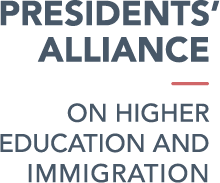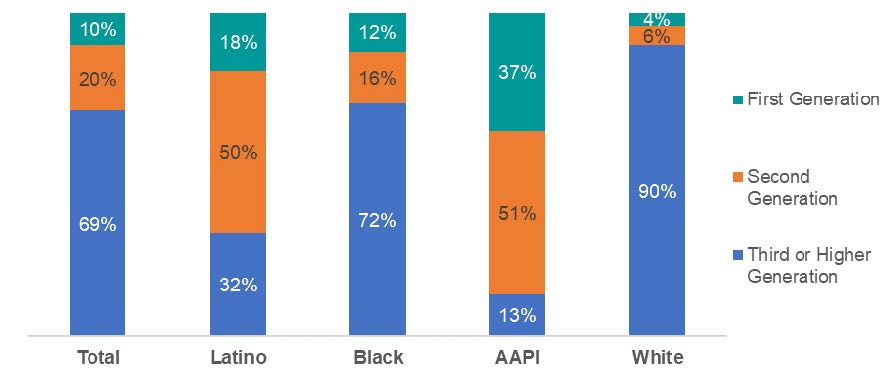Investing in the Future: Higher Ed Should Give Greater Focus to Growing Immigrant-Origin Student Population

*Refers to adults ages 18 to 54 who have at least a high school diploma or equivalent and who were enrolled in college or university at the time of the survey.
Source: Migration Policy Institute (MPI) analysis of monthly data (January to December) from the U.S. Census Bureau’s 2021 Current Population Survey (CPS), accessed via IPUMS-CPS, University of Minnesota, available here.
Immigrant-origin students also represent a significant portion of enrolled racial and ethnic minorities: 88 percent of all Asian students were from immigrant families, as were 68 percent of all Latino students and 28 percent of all Black students. In contrast, just 10 percent of non-Latino Whites were of immigrant origin.
Figure 2. Students Enrolled in Postsecondary Education, by Race/Ethnicity and Immigrant Generation, 2021*

*Refers to adults ages 18 to 54 who have at least a high school diploma or equivalent and who were enrolled in college or university at the time of the survey. Latinos can be of any race but are not reflected in other racial categories here. The sum of the percentages by subgroup may not add up to 100 percent due to rounding.
Source: MPI analysis of the U.S. Census Bureau’s 2021 CPS October Supplement 2021, accessed via IPUMS-CPS, University of Minnesota.
The lion’s share of the immigrant-origin student population is comprised of minorities: 44 percent (or 2.5 million) were Latinos, followed by 24 percent (1.3 million) Asian American and Pacific Islander (AAPI) students, and 13 percent (744,000) Black students (see Figure 3). Among students from U.S.-born families, the share of racial and ethnic minorities was significantly smaller (under 30 percent), while non-Latino Whites made up 70 percent.
Figure 3. Racial and Ethnic Composition of Students Enrolled in Postsecondary Education, by Immigrant Origin, 2021*
*Refers to adults ages 18 to 54 who have at least a high school diploma or equivalent and who were enrolled in college or university at the time of the survey. Latinos can be of any race but are not reflected in other racial categories here. The “other” group includes people who reported their race as multiracial or American Indian. The sum of the percentages by subgroup may not add up to 100 percent due to rounding.
Source: MPI analysis of the U.S. Census Bureau’s 2021 CPS October Supplement, accessed via IPUMS-CPS, University of Minnesota, available here.
Immigration Status and Postsecondary Education
The opportunities for postsecondary education among immigrant-origin students are influenced by their U.S. citizenship and legal status. Whereas having U.S. citizenship opens many doors, lack of legal status acts as a major barrier to credential acquisition. While all second-generation immigrant students are U.S. citizens by birth, their immigrant parents and other family members may be affected by immigration policies, as will many first-generation students.
Among first-generation immigrant students, 56 percent are noncitizens. These 1.1 million noncitizen students hold a wide range of immigration and legal statuses, including as legal permanent residents, resettled refugees, asylees and asylum seekers, dependents of temporary visa holders, and unauthorized immigrants who hold Deferred Action for Childhood Arrivals (DACA) or Temporary Protected Status (TPS), or lack any status. These students, legally present and unauthorized alike, face different barriers and opportunities depending on their specific status, state of residence, and the type of institution they attend. For example, DACA recipients (unauthorized immigrants brought to the United States as children)
have temporary deportation relief and work permit eligibility but do not have access to federal financial aid; their access to in-state tuition and state financial aid is dependent on their states’ policies.
Given the growing campus presence and economic potential of immigrant-origin students, it is crucial to pay greater attention to this population. Prior research has shown that their access to higher education is influenced by their immigration status and racial/ethnic background, which are in turn affected by immigration and education policies and legal decisions. Colleges and universities can take steps to reduce barriers and create opportunities for these students, such as facilitating naturalization processes for eligible noncitizens while supporting pathways to legal status for other immigrant students.
The Supreme Court Ushers in New Era
Looking ahead, the Supreme Court’s recent historic decision to strike down race-conscious admission policies is almost certain to have far-reaching effects on the entire postsecondary education system. In a new era of decision-making when race may no longer be considered directly as a factor for admission, universities and colleges will need to look more closely at their prospective students if they intend to maintain their commitment to serving diverse communities. Institutions that take into account a broader understanding of assets and talents, such as resilience and intercultural competencies arising from immigrant experiences, and a wider range of factors, including overcoming adversity due to immigrant status, will be better positioned to identify and attract a diverse and talented student population.
Failure to understand the complex story behind the demographic, labor force, and college enrollment trends that are shaping the United States—and the role of the immigrant-origin population—undermines the development and implementation of policies that boost credential attainment for a large number of current and future U.S. workers. Investing in increasing higher education access for all students, including those of immigrant origin, is essential for the future well-being of U.S. communities and the U.S. economy.






